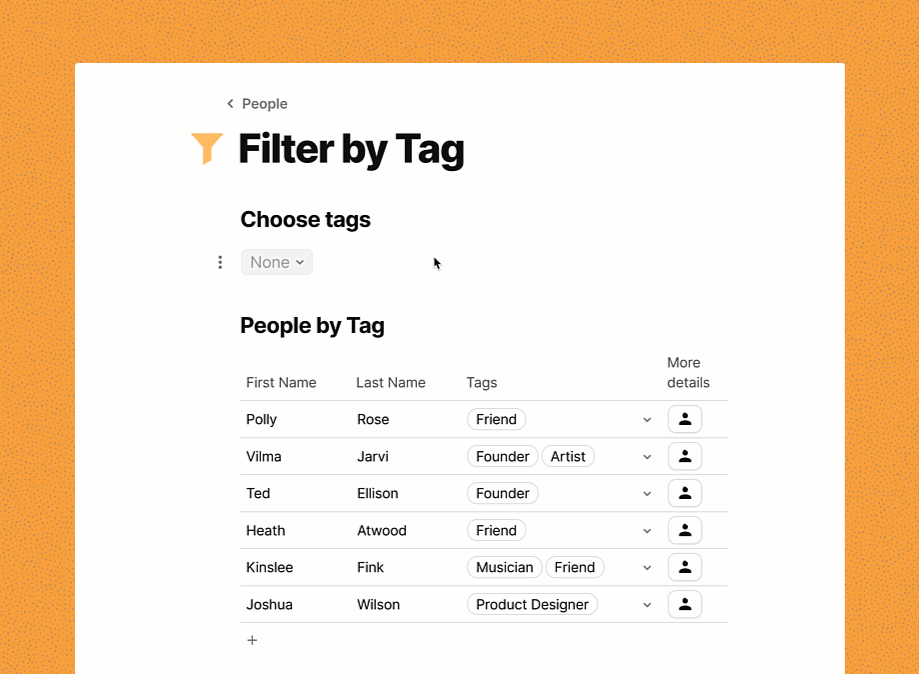Skip to content
How and when we got connectedThe names of their family members — partner, kids, siblings, etcMy current understanding of their potential superpowerWhat I’ve learned from them, and what others might learn from themOpportunities to meaningfully help them

Create a time block that allows for immediate follow-up. For most people-related meetings, especially if it’s a first meeting, I schedule them for 45 minutes. The last 15 minutes of the hour block is left unscheduled, leaving time for follow-ups.Write down opportunities to help. If you’re taking notes during the meeting, write down any opportunities you hear to help that person. One thing I’ve become better at over the years is listening for moments where I can help. Sometimes they surface as a statement like ‘I’m not sure what to do about X’, or sometimes they’re more explicit like ‘I wanted to get your help on Y.’ Either way, I try to write these down in a separate space as soon as I hear them. That way, I can decide later if and how I might be able to help that person.Write and schedule the follow-up directly after the meeting. Most people wait until the end of the day or end of the week to write the follow-up email or next action on a meeting. But I’ve found it’s too easy to get sucked into other tasks. So I try to write the actual email I plan to send as follow-up directly after the chat, while it’s fresh. Then I’ll schedule the email to send whenever seems appropriate. As an example, if it’s a simple ‘thanks’ for the discussion, I might schedule to send it the next morning. Or, if the person has a big event coming up, I’ll schedule the check-in email for the day after the event to ask how it went.

Do you know any great product leaders I should talk to about X?Can you connect me to someone at Y company?I’m traveling to Z city, who should I talk to?

‘Shoot, I can’t remember X person’s kids name, embarrassing...’ → added Kid's name column.‘Y person’s superpower is leading, why not track this for everyone...’ → added Superpower column‘I wish I could draft the email now instead of waiting...’ → setup for draft email sending

 Human Relationship Management (HRM): track your relationships to build for the long term.
Human Relationship Management (HRM): track your relationships to build for the long term.
Personal CRM is a popular term in tech, but it’s always made me cringe.
For the uninitiated, CRM stands for ‘customer relationship management.’ In practice, the term centers around companies and sales teams managing relationships with prospects and customers. The end goal is often driving metrics like revenue. That’s great for businesses, but doesn’t feel quite right for keeping in contact with friends and people that I’m invested in for a lifetime.
So, a few years ago, I built my own little way of tracking all the interactions I have with people. It’s evolved into what most would call a personal CRM. Along the way, I’ve made a handful of tweaks to keep the focus on creating lasting relationships with other humans. More on this later, but I try to anchor the system in what makes people unique, how I might help them, what I’ve learned from them, and what we might create together. That made it feel more ‘human’ so I called it my human relationship manager, or HRM for short.
After sharing it with my team, a few people encouraged me to share it more widely, so here you go. If it’s helpful to you — great, copy it 👉 and make it your own! If you already have the perfect system, I’d love to hear about it so that I can continue to improve my own — DM me on .
Copy doc


I used to suck at follow-up.
Early in my career, I sucked at following up with people. I was introduced to some really amazing humans, only to drop the ball on maintaining the relationship after the initial meeting. As one example, when I moved to San Francisco in my early twenties, I was fortunate to get invited to a weekly breakfast with an amazing group of founders, engineers and product people. I never kept notes or followed-up with most of them. In the subsequent years, this group of people went on to produce some of the best startups in the last 15 years. And I missed the chance to help them create products, invest in them, and create lasting relationships. I’m still kicking myself.
Why? First, I didn’t have a system. And second, I had yet to see what ‘great’ looked like.
Nowadays, as the CPO of Coda, I’m fortunate to chat with lots of amazing people. They’re candidates, potential partners, long-time friends, people I’m mentoring or getting mentored by, family members, and more. And it’s surprising how few people are great at following-up. Sending simple thanks, clarifying next steps on a request, making an introduction to another person, or requesting a future check in — most people just don’t do it.
Who cares? Well, the truth is that high-quality follow-up messages will set you apart from almost everyone else. There’s an asymmetry to be taken advantage of when most people suck at something and you’re good at it. And the good news is, it doesn’t take much to be great at it. You can build a system once, make it your default behavior, stick to it and reap the rewards.
4 steps to creating an easy, human-centered habit.
One of the biggest realizations of my career is that if you want to make real progress on difficult problems over a sustained period of time, then you need a system. And ideally a system that can easily evolve through all the life changes and career transitions you’ll encounter. I learned this first hand from people like , my boss for many years.
You don’t rise to the level of your goals, you fall to the level of your systems.
Personal CRM systems are no different. If you don’t have a system for building and maintaining long-term relationships with people, you’ll drop the ball like I did. Early in my career, I didn’t have a system. Now I do! It’s a bunch of little details that taken together I call my human relationship manager (HRM).
The idea of an HRM is centered on building long term relationships. To do that, you need to discover the interesting elements of someone’s life. What’s their story? What motivates them? What superpowers do they have? What are they currently struggling with?
Every person has an interesting story waiting to be discovered. So here are four key tips for playing the long game and building your own HRM.
(1) Structure: make it easy to capture meaningful information.
Most personal CRMs are focused on people, interactions, and companies. That’s a great start, but it’s inadequate if your goal is to create a system that nudges you toward creating a meaningful, ongoing relationship with that person.
In my HRM, there are a few bits of personal information that I gather and update in a structured way. Examples include fields like:
Here’s a simplified example of what that looks like in my HRM:


And you can play with an example below.
Quickly add person
More details
First Name
Last Name
Tags
Partner Name
Superpower?
LinkedIn
More details
First Name
Last Name
Tags
Partner Name
Superpower?
LinkedIn
Advanced tip: When I asked around for feedback on this doc, Baljeet Singh (a friend and product leader) described how he creates two additional columns in his system. One column reminds him when the interaction is in his court versus needing someone else to follow-up, and another indicates when he’s waiting to hear back from his last message.
(2) Follow-ups: do the follow-up directly after the meeting.
When you have back-to-back meetings all day, it’s easy to get pulled into the next thing, while losing track of important details of the person you just talked to.
Over the years, I’ve adapted my workflow in three key ways.
Here’s my follow-up workflow in Coda, where I write the email directly after the meeting, then schedule it to be sent whenever I prefer.


Here’s how the process appears in the doc, I pick the person, pick the send date & write the draft.


Advanced tip: I was talking to Rushabh Doshi and he mentioned that he takes notes on people interactions in one tool, and then creates follow-ups in his to-do list system. I’ve found that buttons in Coda Packs are an easy way to create to-do’s in tools like and , from the same place you’re recording notes.
(3) Connect: make it easy to find and connect people.
After adding notes in my CRM for a while, I found myself referring back to it regularly to answer questions from people like:
Around that time, I added a simple tagging system to the CRM to make it easier to find and filter sets of people (see ). It wasn’t anything special, just an organic list of tags that I’d add to new (and later existing) people in the CRM. After doing some tagging in the CRM, it became really easy to answer these types of questions, simply by filtering based on tags.


Advanced tip: in talking about the importance of making connections across people, Phil Farhi (a friend and product leader) described how he uses a similar concept when mentoring. If there’s a skill or area where someone needs to or wants to get better at, then he’ll try to point them to people who are good at that to go learn from them.
(4) Reflect: evolve the system based on what you discover.
Whatever system you build, my best advice is stick with it. I recommend using a flexible tool like a spreadsheet or Coda to do this because you simply don’t know all your needs when you start. Said differently, if you're committed to staying with the system for years, what you need will evolve over time. Here are some examples of how the evolution came out in my case:
Make your own, and customize it to your needs.
I’m passionate about making it possible for people to build their own tools. For me, the matter is personal. I came to Silicon Valley in 2005 with a non-technical background, and had to teach myself computer science and software development to get the roles I wanted inside of Google and YouTube.
To me, HRM is a perfect example of how we’re removing gatekeepers to building tools. We’re moving from a world where professional software engineers build tools for people they don’t know, to a world where it’s possible for anyone to start with a simple doc and make it into a tool that fits their needs.
Ready to create your own HRM system?
Copy this doc
Acknowledgements
Big thank you to everyone that gave insightful feedback on this doc and helped me improve it!
Erin Dame, Justin Hales, Shishir Mehrotra, Brian Klein, Rachel Colson, Rick Klau, Hunter Walk, Shiva Rajaraman, Rushabh Doshi, Lenny Rachitsky, Phil Farhi, Baljeet Singh, Paul Stiff, Robin Biggio, Seth Gutierrez, David Kossnick, Carlo Jöerges
Want to print your doc?
This is not the way.
This is not the way.

Try clicking the ··· in the right corner or using a keyboard shortcut (
CtrlP
) instead.